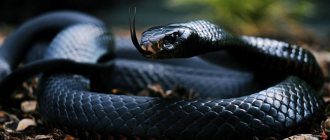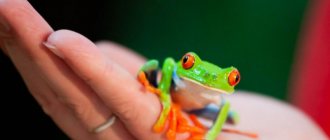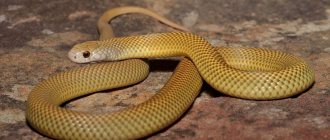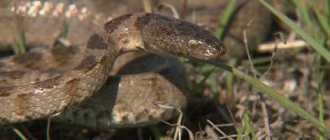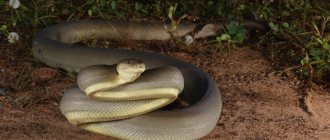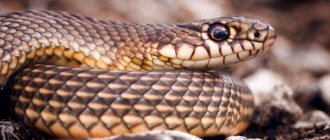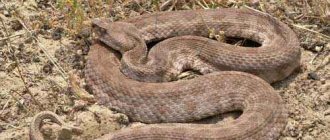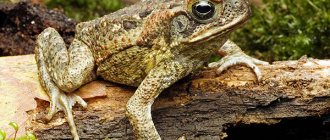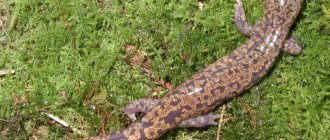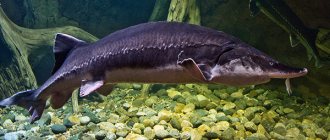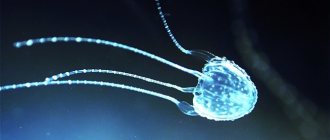- Wild animals
- >>
- Reptiles
The McCoy taipan snake is a fierce reptile and is considered one of the most venomous land snakes. But, since it lives in sparsely populated areas of Australia and is quite secretive, accidents involving bites are rare. This is the only snake in Australia that can change its color. In the hot summer months, it has a light color - mostly greenish, which helps to better reflect the sun's rays and camouflage. During the winter, McCoy's taipan becomes darker, allowing it to absorb more sunlight. It has also been observed that his head is darker in the early morning and becomes lighter during the day.
Scientific name
- Oxyuranus microlepidotus (McCoy)
- Oxyuranus scutellatus (Peters): subspecies scutellatus scutellatus, subspecies scutellatus canni.
Family: Elapidae Genus: Oxyuranus
Note: Some authors still retain the junior synonym Parademansia microlepidota for this species, but it is now common to write it as O. microlepidotus. In some early Australian papers on venomous snakes and snake venom, O. scutellatus is listed as Pseudechis scutellatus and Oxyuranus maclennani.
Common names
Oxyuranus microlepidotus: Western Taipan, Inland Taipan, Fierce Snake, Fierce Snake, Small-scaled Snake. Oxyuranus scutellatus Taipan: common taipan. Oxyuranus canni: taipan from New Guinea
These three species are inland, coastal and central geographic zones. Each species is named after its habitat.
Boomslang
Boomslang is the seventh most powerful snake venom. It belongs to the colubrid family; in African languages its name sounds like 'tree snake'. The species is distributed in tropical Africa south of the Sahara. Snakes of this species are not very picky, so they settle in a wide variety of biotopes.
The average length of a boomslang does not exceed 160 cm. It is easy to recognize the snake by its specific green color with black edges, although females are brown. The reptile weighs up to 0.5 kg, but on average no more than 300 g. The snake climbs trees well and is able to imitate branches.
Boomslang: Wikipedia
It is diurnal and mainly lives in trees. The snake is shy, so it avoids meeting people. All known deaths involve attempts to capture or kill the boomslang. At one time, the snake injects up to 8 mg of poison, which significantly exceeds the lethal dose for humans.
Description of the taipan
Each type is slightly different. The internal species has dark brown scales with a black head. The coastal species has a reddish tint to brown scales. Finally, central taipan species have light, sandy-brown scales.
Depending on the species, individuals usually reach 150 or 180 cm in length. The longest recorded specimen was 290cm long, but some anecdotal reports claim they can reach 335cm in length!
King Cobra
The king cobra is the third most dangerous snake in the world. It is a member of the asp family and is considered the largest among venomous snakes. Some individuals can reach a length of 5.6 m and weigh about 10 kg. Having straightened up in height, a large individual of the king cobra can be eye-level with a person. The cobra lives in the tropical forests of India, Pakistan, the Philippines and Indonesia.
King cobra: Wikipedia
The venom that a king cobra releases at once is enough to kill 20 adults. At the same time, the cobra is a very economical snake. Even if a person provokes it, it can bite empty, without injecting poison.
If the poison enters the human blood, it acts as a neurotoxin. The victim needs immediate medical attention. Otherwise, death from cardiac arrest and paralysis of the respiratory muscles will occur within 15 minutes.
Interesting facts about the taipan
Each type of taipan is slightly different from the other. Find out what makes different species unique.
Coastal Taipan - This species is widely recognized by the scientific community as the largest species of venomous snake in Australia. Despite its enormous size, this snake allows its venom to do all the hard work when hunting. After striking its prey, this snake follows it until the venom incapacitates the prey.
Coastal taipan
Inland taipan. The inland species, also known as the "fine-scaled" or "fierce snake", is native to central Eastern Australia. Its venom can kill an adult in 30-45 minutes without treatment. However, this species is quite shy and tries its best to avoid a threat rather than fight it.
Inland taipan
Central Taipan - Researchers first described this species in 2007. Another 3 years passed before researchers discovered another species of central taipan.
Central Taipan
Sea monster
Remember above we talked about an important note and that the taipan is land? So, there is a snake in the world that is almost 100 times more poisonous than the taipan. It is a sea snake and is called Belcher's snake. A few milligrams of poison can kill a thousand people. However, the snake is peaceful, and most often fishermen suffer from its bite when they take their nets out of the water.
It lives in North America and Southeast Asia. The snake loves reefs very much and can stay underwater for about eight minutes, so it is mainly located there.
The venom contains myotoxin, which destroys muscles. However, when biting, a snake uses no more than a quarter of all its poisonous “reserves”. This is why most people bitten by Belcher's snake survive.
Taipan habitat
These snakes live in a wide variety of habitats, depending on the species. We know very little about the species found in Central Australia, but coastal and inland species occupy different habitats.
The inland species prefers semi-arid habitats with little rainfall. Lives in deserts, plains and similar regions. In contrast, coastal species inhabit more tropical regions with high rainfall. McCoy's coastal taipan occupies tropical forests, woodlands, dry forests, monsoon forests and more.
Three different species live in different regions of Australia. You can find coastal species...you guessed it...along the coast! It extends along the coastline of northern Australia from north-east Western Australia through the Northern Territory and along the coast of Queensland.
Interior view of a taipan snake in nature
Like its coastal counterpart, the inland view also lives up to its name. This species is found in the central regions of Queensland, New South Wales and South Australia. Researchers also believe the species found in the Central Regions are native to inland Australia, but do not have sufficient data to know their range.
Kaisaka
The eighth most poisonous snake is the kaisaka. This is the largest snake among the spear-headed vipers. It can reach from 2 to 2.5 m in length. The snake is easily recognized by its brown color with pronounced rhombuses on its back, trimmed with a black stripe. The snake's chin is yellow, which is why it is nicknamed the yellowbeard.
Kaisaka: Wikipedia
The snake lives in Central and South America. The largest number of snake attacks on humans is recorded on banana and coffee plantations. There, kaisaks hunt small rodents. The reptile is well camouflaged and invisible when stationary. Snake venom destroys blood vessels and can cause bleeding, kidney failure, blood clotting and even stroke.
Taipan and human interaction
For the most part, these reptiles avoid interaction with humans. They are fast-moving snakes and usually run away when a person gets too close. However, if they feel caught or cornered, they become defensive. Coastal species are more aggressive than inland species.
Taming
Humans have not domesticated this snake in any way.
Would a taipan snake make a good pet?
No, none of the three species make good pets.
These snakes have very toxic and dangerous venom and a bite can kill you. These snakes are kept in zoos and research centers to educate the public and collect venom to create a life-saving antidote. Only trained people should handle these venomous snakes. They use snake tongs if they need to move the snake from its closet for cleaning, or feed them rats and mice.
Taipans are a relatively small cause of snakebites in Australia relative to the number of cases. Without proper antivenom treatment, up to 75% of taipan bites will be fatal. Indeed, in the era before specific antivenom therapy, there were practically no recorded survivors of a taipan bite.
Taipan snake ready to strike.
Main risks: neurotoxic paralysis, coagulopathy, rhabdomyolysis, acute renal failure.
Target organs: neuromuscular junction, coagulation system, skeletal muscle.
Nutrition
They feed on mice, rats, chicks, and sometimes lizards or toads. The video with the taipan snake shows how careful they are, despite all their aggression. Having stung his prey, he does not rush after him, but lies on the sidelines until the poor fellow dies.
This behavior of the snake is justified so as not to suffer from the poisoned victim, for example, a rat, being under great stress, can rush at the snake and bite or scratch. After eating, the snake will lie down somewhere in a hole, or hang on a tree until it gets hungry again.
Taipan venomous apparatus and venom composition
The poison is produced by paired modified salivary glands, superficially located under the scales behind the eye, and surrounded by muscles, the contraction of which compresses the glands, expelling the poison anteriorly through the poisonous ducts to the fangs.
The canines are also paired, located in the front part of the upper jaw, on the maxillary bones. They have a closed groove for transporting venom, exiting near the tip of the fang.
The length of the fang in adult taipans varies and depends on the species:
- O. microlepidotus, 3.5 - 6.2 mm;
- O. scutellatus, 7.9 - 12.1 mm.
Average poison yield:
- O. microlepidotus, 44 mg, max. 110 mg;
- O. scutellatus, 120 mg, max. 400 mg.
Medium poison is injected first with a bite (defensive blow):
- O. microlepidotus, 17.3 mg, range 0.7-45.6 mg, average amount of venom on skin 0.6 mg;
- O. scutellatus, 20.8 mg, range 0.6-68.9 mg, average 0.9 mg venom on skin.
Sandy efa
The fifth place is occupied by the sand faff. This poisonous species of viper lives in the Middle East, Central Asia and India. The snake can also be found in Uzbekistan, Turkmenistan and Tajikistan.
The sand epha is a small snake. In length it reaches from 38 to 80 cm, on average it grows to 60 cm. The snake’s muzzle is short and rounded, noticeably different from the body. The color pattern consists of pale yellow, grayish, reddish, olive or pale brown.
Sand faff: Wikipedia
The sand ephas is one of the "big four" snakes responsible for the largest number of human bites in the Indian subcontinent. In one bite, the snake injects about 12 mg of venom, which is several times higher than the lethal dose for humans. However, due to the prevalence and availability of antivenom, the person bitten has a high chance of survival.
Major Toxins
Oxyuranus venom is a complex mixture of proteins and non-protein substances. Neurotoxins: both presynaptic (typoxin) and postsynaptic.
Procoagulants: Mainly factor Xa analogues, acts largely independently of cofactors (eg factor V, calcium, phospholipid) to convert prothrombin to thrombin (mesiothrombin).
Myolysins: second action presynaptic neurotoxin (eg, typoxin), which contain a phospholipase A2 component.
Fastest in the world: black mamba
Habitat: Africa.
A large, poisonous, aggressive and cruel snake of the mamba genus is a thunderstorm of the continent and is one of the most poisonous in the world. She is also listed in the Guinness Book of Records as the fastest . The black mamba can move at a speed of 18 km/h, which is approximately equal to the average running speed of a trained person.
One bite is usually not enough for her. She prefers to finish off the victim and therefore injects several portions of poison, injecting from 100 to 400 mg. A person only needs 15 mg to die.
The venom of the black mamba is not only a deadly weapon, but also a powerful painkiller. French biologists used one of its key components, the toxic proteins mambalgin, to make an analgesic. It is stronger than morphine and is not addictive.
Taipan behavior
Behavior varies from species to species. They are mainly active during the day. In very hot weather, these snakes become nocturnal and feed at night.
Taipan snake crawling
They are most active in the early morning when they use their keen vision to search for prey. Once they spot prey, they quickly attack and then hunt down the prey after it has died.
The story of a snake
In fact, there were legends about taipans for a long time, and not everyone believed in their existence, because they had practically no contact with people. The taipan was first described in 1867, and then, for half a century, there was no information about the snake.
The snake was studied in more detail in 1950. Young catcher Kevin Baden caught the reptile on June 28, 1850. However, the guy was unlucky: the taipan bit his finger and he died. But the snake was still taken to the scientific center.
Blue krait (Bungarus candidus)
This is a very beautiful sea snake. But her appearance is deceiving. This is an incredibly poisonous specimen. It is found in Asia and Indonesia. They are nocturnal. The blue krait's venom is so toxic that even 50% of people given the antidote still die.
But there is also good news. As with the species described above, this one is also not aggressive. These are timid sea animals that prefer not to come into conflict with humans.
As for the statistics, they are not very happy. Approximately 85% of people bitten by this snake die.
What you should not do if you are bitten by a viper
Under no circumstances should a tourniquet be applied to an injured limb. If its blood supply is disrupted, the limb can become dead within just a few minutes. After removing the tourniquet, tissue decay products will enter the body, which will poison it more than the poison itself.
You should not burn the bite site. This is not only useless, but also very traumatic, since the venom of the viper penetrates deep into the tissue.
You should not cut the bitten area, as this can lead to infection of the wound. The poison is already necrotizing, and such manipulations will only worsen the situation.
Bloodletting is prohibited. The amount of poison in the circulatory system is completely insignificant. It already destroys blood cells, so additional bleeding will lead to dire consequences.
Vegetation, soil, etc. should not be applied. to the site of the bite. This way you can get tetanus.
It is prohibited to drink alcohol. It dilates blood vessels and promotes faster spread of poison.
Very beautiful: two-color bonito
Habitat: waters of the Indian and Pacific oceans.
One of the most poisonous snakes is also considered one of the most beautiful. The reptile attacks people solely in self-defense, but if it bites, it will surely do so. Its poison is capable of killing three people.
Using the bicolor bonito as an example, a group of scientists from the USA, Australia and France found that sea snakes can survive without water for up to seven months. Biologists observed the reptiles for three years and found that they quench their thirst only with fresh water and do not drink sea water. When a “drought” occurs, they use the body’s reserves, losing up to 25% of body weight.
Creation
In addition to the founder, soloist and producer named Roman, the band also includes musicians Sergei, Yuri and Vyacheslav. Back in 2009, young people founded a group under a different name “Sparta-Project”. One composition from the album was included in the top songs at a music festival called “Kazantip”.
But from that time on, the guys’ careers did not work out, the reason for this was, as the young people themselves say, the excessive ambition and brightness of the performers. 10 years have passed since then and all this time they have been making music separately. Roman, for example, performed under the well-known pseudonym DJ Romira and managed to work with many DJs (for example, DJ MEXX).
At the beginning of 2022, the guys decided to try their hand again and united in the Taipan group. This name arose for a reason, because the taipan is one of the most dangerous and poisonous snakes, the bite of which can kill instantly.
In just a year, the group managed to release such songs as: “Mulaya”, “Childhood”, “Ay”, “New Year”, “Medina”, “School”, “Drunk” and several more compositions.
Today the guys are preparing to release another hit - the song “Ship”. It is noteworthy that the group writes the lyrics and music for their works themselves. And they draw inspiration from emotions, personal experience and events happening around them.
A great success and luck for them was the collaboration with a young and promising performer from Vladikavkaz named Agunda. This girl became instantly popular by recording just one viral and beautiful song. Their joint song called “Moon” today ranks first in various tops and music charts on VK, Shazam, and is also on the list of the most popular songs in Yandex.Music and BOOM.
The guys are regularly invited to various shows, and recently they visited the Autoradio studio for the “Let's Go” show. They also recently gave an interview to journalists on the TV-6 Kursk channel and talked about plans for the near future.
What does the viper eat?
Photo: Poisonous viper
The menu of different subspecies of viper differs, because... The areas of its habitat and the presence of this or that living creature in the inhabited territory are also different. In some areas, the snake menu consists mainly of all kinds of rodents, in others - from birds. The birds are eaten by reptiles that have settled in Central Asia.
In the viper menu you can see:
- Common house mice;
- Gerbils;
- Vole mice;
- Jerboas;
- Khomyakov;
- Young hares will be born;
- Hedgehogs;
- Small turtles;
- Geckos;
- Various lizards;
- Insects;
- Polozov;
- Yellowbellies;
- Baby porcupine.
This is how varied the diet of this most dangerous snake is. It should be added that only a very hungry viper attacks reptiles; it does this when it cannot find other prey. The viper hunts birds from an ambush located near the water. Birds that come to drink often become victims of a snake, which pounces with lightning speed and bites the victim with sharp teeth. Sometimes the bird manages to escape, the viper does not pursue the victim, who soon falls, struck on the spot by a strong poison.
It should be noted that the viper, which has settled on cultivated land, provides enormous benefits to humans, destroying many rodent pests.
